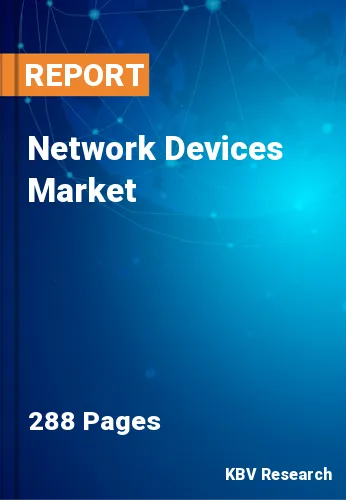
The Global Network Devices Market size is expected to reach $38.4 billion by 2028, rising at a market growth of 6.3% CAGR during the forecast period.
Network devices, often known as network equipment, are many types of electronic devices that are utilized in networking. These kinds of devices are primarily deployed in computer networks to send and receive data swiftly and securely between computers, printers, fax machines, and other devices. Such devices could be intranet or internetwork devices. Certain devices are mounted on the device, like RJ45 connectors or NIC cards, while others are part of the network, like switches and routers. These are specialized devices that manage digital or electrical connections in order to execute their unique functions effectively.
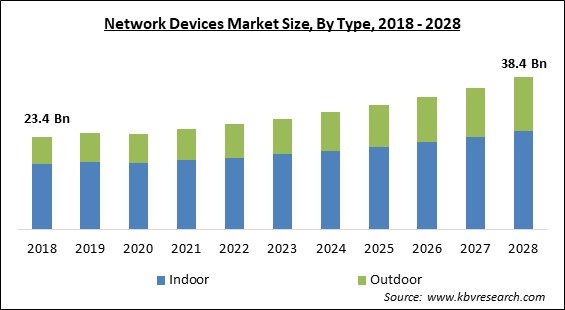
Numerous ports may be available on APs, which could be utilized to expand the network's capacity, firewall features, and Dynamic Host Configuration Protocol (DHCP) service. As a result, companies have access points that operate as a switch, router, DHCP server, and firewall. A service set identifier (SSID) name is required to access a wireless AP. The SSID is used by 802.11 wireless networks to distinguish all systems that connect to the same network, and consumer stations should be set with the SSID in order to connect to the AP. The AP may broadcast the SSID, making it visible to any wireless users.
But, APs could be set not to transmit the SSID for security reasons, which implies that an administrator must provide the SSID to consumer systems rather than letting it be detected automatically. SSIDs, channels, passwords, security settings, and usernames are all set by default on wireless devices. Since numerous internet sites display the default settings utilized by manufacturers, it is highly recommended that users change such default settings as quickly as possible for security purposes.
There are two types of access points: fat and skinny. Fat APs, which are still often known as autonomous APs, must be manually set up with network and security settings before being left to serve customers until they can no longer function. Thin APs can be configured remotely utilizing a controller. Thin clients can be readily adjusted and managed because they do not require manual configuration. Controller-based and stand-alone access points are both possible.
This dilemma has impacted many end-use verticals that use network devices. The disruption in supply chain across the world has negatively impacted the demand and growth of the network devices market. In addition, the rapid pace of the digitalization among companies and individuals would augment the demand for network devices in the world. The network devices market began to show indications of recovery by the end of 2020, with R&D and growth efforts returning in 2021. These ongoing innovations were predicted to aid the market's recovery in the coming years. As a result, a reasonable growth rate has been set, as the overall network devices market is likely to recover from the impact of the COVID-19 pandemic.
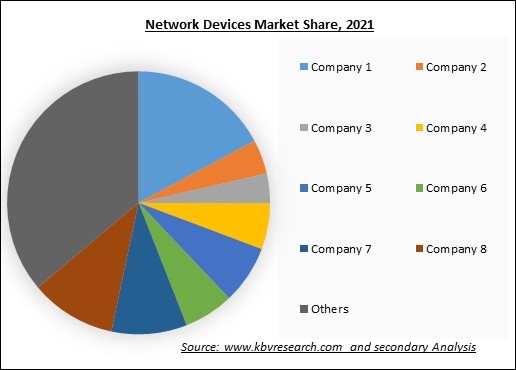
The leading players in the market are competing with diverse innovative offerings to remain competitive in the market. The below illustration shows the percentage of revenue shared by some of the leading companies in the market. The leading players of the market are adopting various strategies in order to cater demand coming from the different industries. The key developmental strategies in the market are Partnerships & Collaborations.
Due to the expanding smartphone penetration and improved connectivity, the number of internet users worldwide is continuously rising. Seek for network devices is anticipated to rise as consumers demand more connected devices, which need advanced Internet connections for flawless performance. While this is opening up prospects for broadband and telecom businesses, they still have a difficult time keeping up with customer demands for network uptime, capacity, and latency in a cutthroat market. With the aid of improved network equipment, which might offer the necessary connectivity bandwidth, security, and network dependability, players are investing substantially to take advantage of these new opportunities. The development of cellular-based network devices is anticipated to be fueled by telecom companies' growing investments in wireless network infrastructure.
The primary elements that are anticipated to propel the expansion of the home networking market are the development of cutting-edge connected items and the low pricing of such devices. To accept print commands from numerous networks and to increase network security system, the system offers several access points to networked devices and home networking equipment, such as printers. These elements contribute to the market for network devices operating more effectively. Along with that, many companies are investing in the advancements of their devices to gain more consumer attention. As a single system can control several devices at once, like Wi-Fi, which provides data to numerous devices at a time, it is possible that telecommunications and IT make up the largest portion of sales of home networking devices.
One of the main issues for many firms is data privacy. Businesses are looking for stronger security and privacy choices to safeguard their networks from online dangers including corporate monitoring, data breaches, and data theft because of the dramatic increase in data volumes. Each endpoint, sensor, gateway, and smartphone has now become a possible target for hackers as a result of the increasing number of systems, which has also led to security and privacy vulnerabilities. Security is a crucial element to take into account when building Wi-Fi networks because the WLAN network gives access to many smart devices.
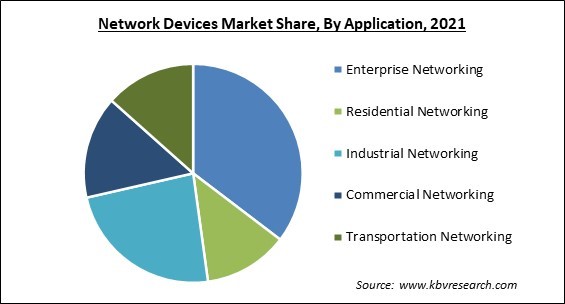
Based on Type, the market is segmented into Indoor and Outdoor. The outdoor segment registered a substantial revenue share in the network devices market in 2021. It is due to the increasing demand for network connectivity in open spaces. Various companies are introducing advanced WiFi solutions for long bandwidth, which can tolerate any weather. In addition, these kinds of network devices offer better performance to the users.
Based on Connectivity, the market is segmented into WiFi, Cellular, WiFi + Others, Long Range Radio (LoRa), and Others. The WiFi segment procured the highest revenue share in the network devices market in 2021. WiFi makes it possible for devices to connect directly to one another or to large networks in order to transmit data. It is a foundational technology for the Internet of Things and mostly uses the 2.4 GHz to 5.0 GHz frequency range. According to connectivity, WiFi is anticipated to dominate the market for network devices over the upcoming years. WiFi connectivity offers the best performance, bandwidth, and total value across gateways, WiFi 5, and newer WiFi 6 & 6E routers, and access points.
Based on Application, the market is segmented into Enterprise Networking, Residential Networking, Industrial Networking, Commercial Networking, and Transportation Networking. The commercial networking segment procured a significant revenue share in the network devices market in 2021. Commercial networks are enormous networks, and the scale is the main distinction between them and home networks. Similar protocols, networking topology, and services are used by commercial networks and their smaller siblings, residential networks.
Based on Device Type, the market is segmented into Routers, Gateways, and Access Points. The routers segment acquired the maximum revenue share in the network devices market in 2021. The demand for wireless routers with a strong connection in the home market is being driven by the escalating demand for high-speed Internet connectivity and the expanding use of smart devices like tablets, smartphones, and smart TVs. During the forecast period, the market for routers for enterprise, industrial, and commercial applications is anticipated to develop due to rising usage of virtualized technologies, expanding cloud networking, and rising demand for Internet-based devices.
| Report Attribute | Details |
|---|---|
| Market size value in 2021 | USD 25.3 Billion |
| Market size forecast in 2028 | USD 38.4 Billion |
| Base Year | 2021 |
| Historical Period | 2018 to 2020 |
| Forecast Period | 2022 to 2028 |
| Revenue Growth Rate | CAGR of 6.3% from 2022 to 2028 |
| Number of Pages | 291 |
| Number of Tables | 474 |
| Report coverage | Market Trends, Revenue Estimation and Forecast, Market Share Analysis, Segmentation Analysis, Regional and Country Breakdown, Competitive Landscape, Companies Strategic Developments, Company Profiling |
| Segments covered | Type, Connectivity, Application, Device Type, Region |
| Country scope | US, Canada, Mexico, Germany, UK, France, Russia, Spain, Italy, China, Japan, India, South Korea, Singapore, Malaysia, Brazil, Argentina, UAE, Saudi Arabia, South Africa, Nigeria |
| Growth Drivers |
|
| Restraints |
|
Based on Regions, the market is segmented into North America, Europe, Asia Pacific, and Latin America, Middle East & Africa. North America emerged as the leading region in the network devices market with the maximum revenue share in 2021. The market in North America is primarily being pushed by the rising use of integrated enterprise & business solutions for even more adaptable and agile company operations. Due to the growing investment in wireless technology by the main corporations in this region, the need for wireless hotspots and Wi-Fi solutions & services is anticipated to expand.
Free Valuable Insights: Global Network Devices Market size to reach USD 38.4 Billion by 2028
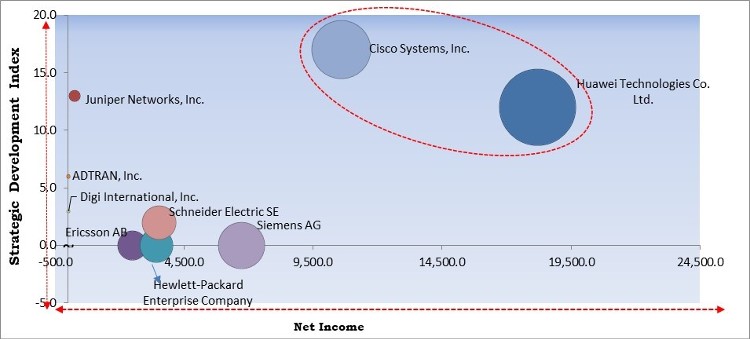
The major strategies followed by the market participants are Partnerships. Based on the Analysis presented in the Cardinal matrix; Cisco Systems, Inc. and Huawei Technologies Co. Ltd. are the forerunners in the Network Devices Market. Companies such as Juniper Networks, Inc., ADTRAN, Inc. and Schneider Electric SE are some of the key innovators in the Market.
The market research report covers the analysis of key stake holders of the market. Key companies profiled in the report include Cisco Systems, Inc.,Siemens AG, Schneider Electric SE, General Electric (GE) Co., TE Connectivity Ltd., Hewlett-Packard Enterprise Company, Juniper Networks, Inc., ADTRAN, Inc., Huawei Technologies Co. Ltd., Digi International, Inc., and Ericsson AB.
By Type
By Connectivity
By Application
By Device Type
By Geography
The network devices market size is projected to reach USD 38.4 billion by 2028.
The rise in the number of internet users are driving the market in coming years, however, Rising concerns related to data security and privacy in open networks limited the growth of the market.
Cisco Systems, Inc.,Siemens AG, Schneider Electric SE, General Electric (GE) Co., TE Connectivity Ltd., Hewlett-Packard Enterprise Company, Juniper Networks, Inc., ADTRAN, Inc., Huawei Technologies Co. Ltd., Digi International, Inc., and Ericsson AB.
The Indoor segment acquired maximum revenue share in the Global Network Devices Market by Type in 2021, thereby, achieving a market value of $24.7 billion by 2028.
The Enterprise Networking segment is leading the Global Network Devices Market by Application in 2021, thereby, achieving a market value of $12.9 billion by 2028.
The North America market dominated the Global Network Devices Market by Region in 2021, and would continue to be a dominant market till 2028; thereby, achieving a market value of $12.7 billion by 2028.
Our team of dedicated experts can provide you with attractive expansion opportunities for your business.
